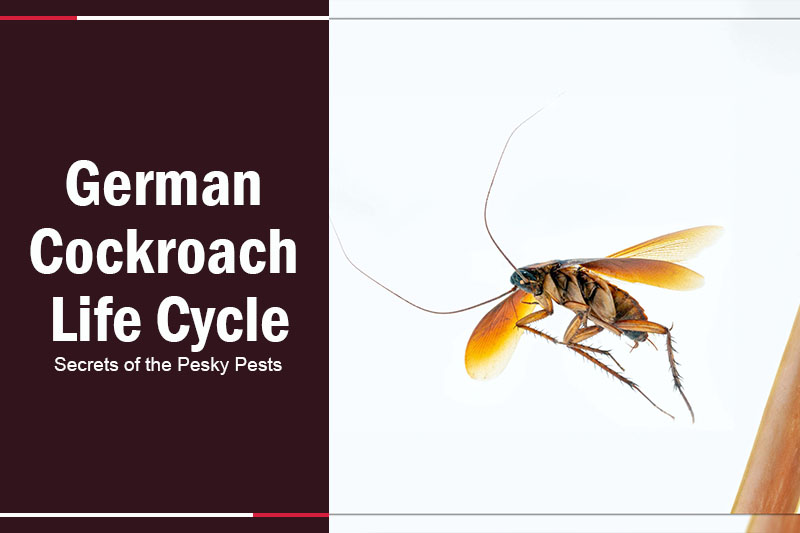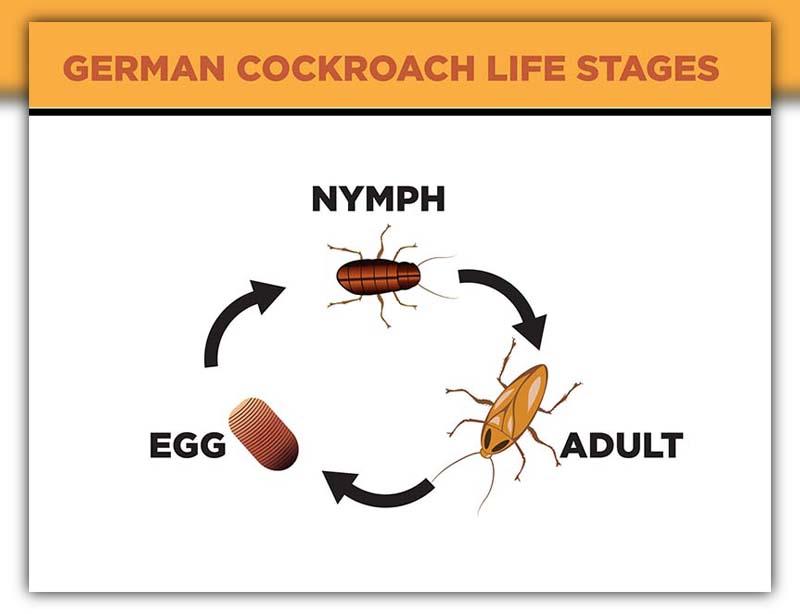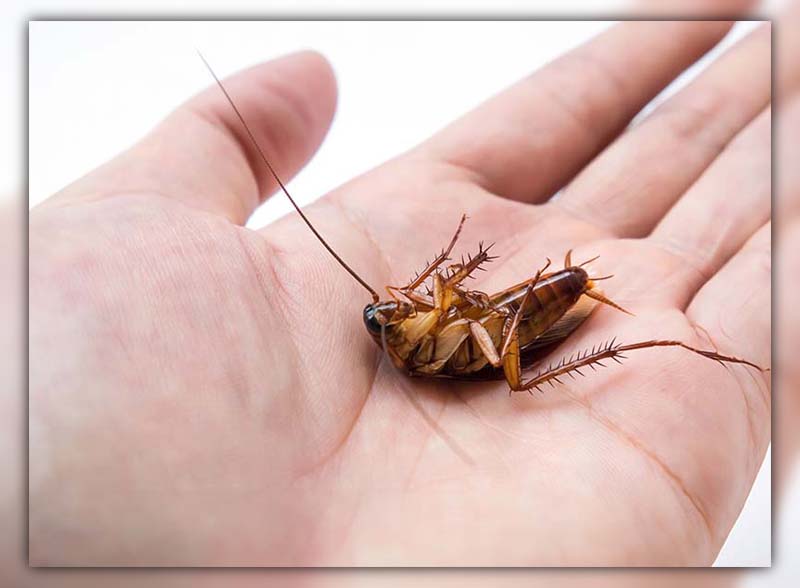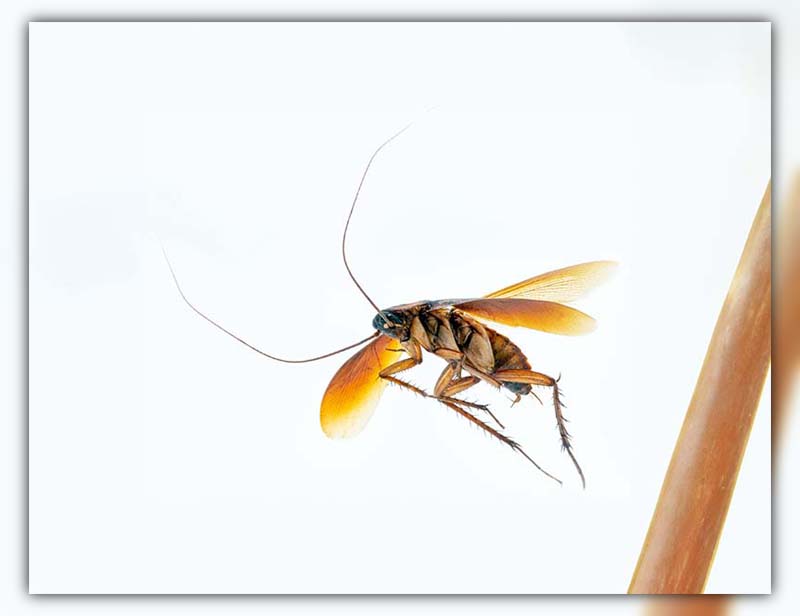The German Cockroach Life Cycle is more fascinating than you might think.
Get an inside look into their world, and you’ll be better equipped to handle these household invaders.

German Cockroach Life Cycle
The German cockroach goes through three main parts in its life: egg, young stage, and grown-up stage. The whole journey takes around 100 days.
But things like how warm it is, how much food there is, and even their family type can change how long it takes.
Here’s an interesting point: German cockroaches keep having babies all the time. So, if you look at a group of them, you’ll find many young ones and a few grown-ups.
Specifically, about 80% are young ones and 20% are grown-ups.
Read more German roach vs Asian roach: Differences & ID Tips!
German Cockroach Eggs
Let’s start at the beginning. The mommy cockroach makes a special case for her eggs. This case, called an “ootheca,” is like a bean and feels a bit rough.
It can hold up to 48 eggs inside. What’s cool is that the mommy carries this case around on her belly until the eggs inside are almost ready to come out.
When it’s time, she hides it in a safe place and sticks it down with a kind of natural sticky stuff.
In a day or two, the case opens, and the young cockroaches, or nymphs, come out.
German Cockroach Nymphs
When the nymphs first come out, they are light-colored, almost white. But in a few hours, they turn dark brown.
These nymphs look like tiny grown-up cockroaches, but they don’t have wings. They grow by shedding their skin about five to six times.
After they do this for the last time, they become grown-up cockroaches.
German Cockroach Adults
Adult German cockroaches are about the size of a small paper clip.
They have two sets of wings. The inner set helps them glide a little, and the outer set is tougher and covers them up. These grown-ups live for about five to seven months.
Here’s something wild: One female cockroach can make around seven to eight batches of eggs in her life. That means she can have around 350 babies.
So, in one year, just one female can be the starting point for thousands of new cockroaches!
These grown-ups are tough too. They can go a month without eating but need water every two weeks or so.
German cockroach: Habitat and Behaviour
German cockroaches love warm and damp places.
Their main goals indoors are to find food, water, and a cozy spot to chill and have babies.
You can often spot them in various places at home:
- Around kitchen gadgets
- Bathrooms
- Beneath sinks
- Inside dishwashers
- Medicine cupboards
- Cleaning closets
- Hidden spots in ceilings
- Food storage areas, like pantries
While they don’t typically wander from one building to another on their own, they’ve hitched rides in packages and boxes, spreading to nearly every place on Earth. They’ve even been spotted as far north as Alert in Nunavut.
When it comes to food, German cockroaches aren’t picky. They’ll eat almost anything. But they have favorites like sweets, oily stuff, grains, and meat. If there’s a big group of them and food is scarce, they get creative. They might munch on glue, snack on packaging, nibble on humans, or even eat each other.
German cockroach reproduction
German roaches have quite the reputation for multiplying rapidly. Here’s how they do it:
A female roach can create between 4 to 8 egg sacs, known as oothecae. Interestingly, each of these sacs can hold an impressive 30 to 48 eggs.
When it’s almost time for these eggs to hatch, the mother roach finds a safe spot to place her ootheca.
Typically, the eggs take between 20 to 30 days to hatch.
However, if it’s warm, like in cozy spots inside the house or under appliances especially if the temperature is above 77°F this period can be shorter.
And in a brief span, she’s ready to produce another egg sac.
Read more Albino Cockroach: Decoding the Pale Pest Mystery
Do German cockroaches bite?
German cockroaches or Blatella germanica are pretty common in Canada. While they can bite, it’s a rare thing.
These bites mostly happen when people are deep in sleep. These bugs are night owls and aren’t fussy eaters.
So, if there’s a little food left on your skin, they might consider it a snack.
Especially for babies or young ones, leftover milk or food around the mouth is like an invite for these roaches.
But here’s some relief: there’s no strong evidence saying they spread diseases through their bites.
If they do bite, you might see a small red mark which could later form a scab. Identifying a roach bite isn’t always easy.
They eat a variety of things, from crumbs to our dead skin, making them venture close to humans.
They can also carry germs, so a bite could become a problem if it’s not cleaned.
To keep them away, cleanliness is your best friend. Clean up after you eat, avoid snacks in bed, and keep eating areas separate from sleeping spots.
Also, declutter, seal up cracks, and be watchful of their favorite hiding places to ensure a roach-free home.
Read more Cockroach milk benefits? What Is It and Should We Use it?
Do German Cockroaches Fly?
Even though both male and female German cockroaches have wings, they seldom use them to fly.
Instead, they tend to run or scuttle across surfaces.
Conclusion
In wrapping up our deep dive into the German Cockroach Life Cycle, we’ve unveiled the intriguing journey of these common pests, from eggs to active adults.
Understanding their lifecycle not only educates but empowers us in managing these unwelcome guests more effectively. Don’t forget to explore more blogs from Pestweek.

Calina Mabel has over 15 years of experience in the field of journalism and communications. Currently, Calina Mabel is the Content Writer for categories such as Cockroach, Ants, Bed Bugs, Mosquito, Rodent, Termite, and Flies on Pestweek.com. She aims to build content for these categories with a focus on providing valuable and accessible information to readers, in order to create the world’s largest knowledge community about Pests.
All content written by Calina Mabel has been reviewed by Emily Carter.




